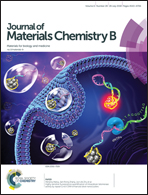Hydrogen-producing hyperthermophilic bacteria synthesized size-controllable fine gold nanoparticles with excellence for eradicating biofilm and antibacterial applications†
Abstract
Herein, we employed the hydrogen-producing hyperthermophilic bacterial strain Caldicellulosiruptor changbaiensis for preparing uniform and size-tunable gold nanoparticles (AuNPs). Compared with the commonly used chemically synthesized nanoparticles, the biological synthesis of nanoparticles appears to be a suitable process since it has a low manufacturing cost of scalability, good biocompatibility, and better nanoparticles stabilization. The produced AuNPs possessed a unique property, whereby the smallest AuNPs exhibited the highest peroxidase activity over a broad pH range, even at neutral pH, which was quite different from the commonly chemical-synthesized ones. Also, when the size of AuNPs increased, the peroxidase activity of B-AuNPs at neutral pH decreased. Owing to the excellent antibacterial capability of ROS, the AuNPs exhibited striking antibacterial properties against both Gram-positive and Gram-negative bacteria, and moreover, the AuNPs showed excellent ability to disperse bacterial biofilms both in vitro and in vivo. Our studies indicate that living bacterial cells, as a biosynthesizer, can synthesize size-controllable AuNPs with improved bioactivity. This work may promote the design and synthesis of other types of metal nanoparticles with defined properties for future applications.



 Please wait while we load your content...
Please wait while we load your content...